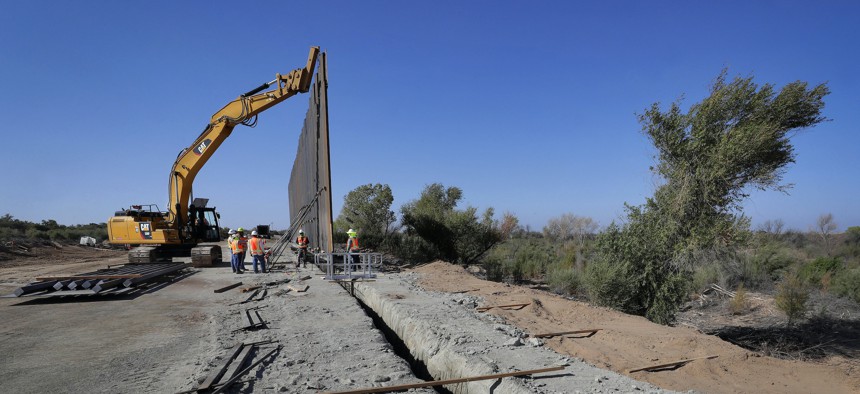
Government contractors erect a section of Pentagon-funded border wall along the Colorado River, in Yuma, Ariz., in November 2019. AP / Matt York, File
The Pentagon Is Funding the Destruction of Cultural Heritage
Construction of Trump’s border wall is undermining not just sacred sites but the rule of law itself.
Say “cultural heritage destruction,” and many Americans may think of ISIS’s obliteration of religious and archaeological sites in Syria and Iraq, or the Taliban’s demolition of Afghanistan’s Bamiyan Buddhas. But irreversible damage to sites of cultural importance doesn’t just happen at the hands of terrorist organizations. Even as the Department of Defense takes steps to protect cultural heritage overseas, U.S. military funds are being used in a project that is destroying it right here in the United States: the Trump administration’s construction of a wall on the U.S.-Mexico border.
Dozens of Indigenous groups have homelands along the border. Several of these groups, from the Kumeyaay people in California to the Carrizo/Comecrudo people in Texas, have challenged the wall’s construction on the grounds that sacred sites would be damaged or destroyed. Yet construction has gone forward, thanks in large part to the Trump administration’s appropriation of about $10 billion from the Pentagon’s budget. In February, contractors paid with military funds blew up land sacred to O’odham communities in the Organ Pipe Cactus National Monument in Arizona. “This disrespect for our sacred sites and their desecration at the hands of our federal government is deeply painful,” Ned Norris Jr., Chairman of the Tohono O’odham Nation, told Congress.
The Trump administration’s use of Pentagon funding to destroy Indigenous cultural heritage is an attack on the rule of law. It flouts both federal and international law, and undermines the legal foundations supposedly designed to protect the rights of Indigenous Americans.
The administration has used legal waivers to get around federal protections of Indigenous cultural heritage. In March, U.S. Customs and Border Protection issued waivers to expedite six areas of wall construction that would be funded by Department of Defense money. The six corresponding Federal Register notices from the Department of Homeland Security cite legal justification to waive the Native American Graves Protection and Repatriation Act and the American Indian Religious Freedom Act. While AIRPA has limited enforceability, NAGPRA is a vital piece of legislation that requires federal agencies to follow strict procedures when they encounter human remains or cultural items on federal or tribal land. The legislation carves a legal avenue for Indigenous Americans to exercise cultural rights pertaining to important aspects of cultural heritage when interacting with the federal government as it carries out construction projects.
These sorts of waivers issued by the Trump administration run completely counter to Congress’ intent in enacting NAGPRA and similar legislation. By legally codifying how the U.S. government should respect human remains and cultural items, NAGPRA helps to counteract the United States’ violent history of oppressing Indigenous people. The administration’s suspension of NAGPRA to pursue a policy objective sends a clear signal that the U.S. legal system won’t consistently protect the rights of historically persecuted people.
The destruction of Indigenous cultural heritage on U.S. soil also stands in opposition to one of the few pieces of related international legislation to which the U.S. has actually committed: the International Covenant on Civil and Political Rights. “In those States in which ethnic, religious or linguistic minorities exist, persons belonging to such minorities shall not be denied the right, in community with the other members of their group, to enjoy their own culture, to profess and practise their own religion, or to use their own language” states Article 27 of the treaty, which the U.S. ratified in 1992. Indigenous Americans constitute ethnic minorities, and the destruction of cultural sites denies their members the right “to enjoy their own culture” in addition to also often denying them the right to “practise their own religion.”
By ratifying the International Covenant on Civil and Political Rights, the U.S. made a commitment to uphold the rule of law. Destroying cultural sites to make way for the border wall is a clear violation of such a commitment. The cost of this violation is weakened protection of the rights of Americans.
“No matter what the current political debates are about the border, we must unite and stand against the unjust destruction on the border,” writes Verlon Jose of the Tohono O’odham Nation. As Americans, it is all our responsibility to stand with O’odham, Kumeyaay, Carrizo/Comecrudo, and dozens of other indigenous communities to uphold the rule of law and address the United States’ legacy of persecuting and perpetrating genocide against Indigenous people. That means opposing Pentagon funds—or any funds—going to cultural heritage destruction on the border.
David Elitzer specializes in the study of state violence, cultural heritage destruction, and democratic backsliding. A Marshall Scholar with graduate degrees from the University of Cambridge and University College London, he is currently a research assistant with the Alfred Landecker Programme at the University of Oxford’s Blavatnik School of Government.
NEXT STORY: Esper's Convenient Lie



